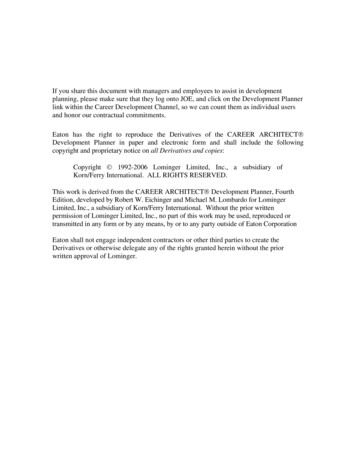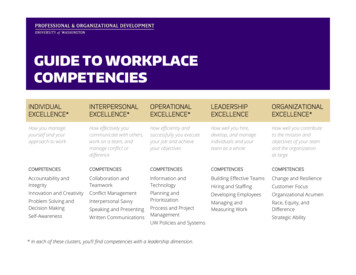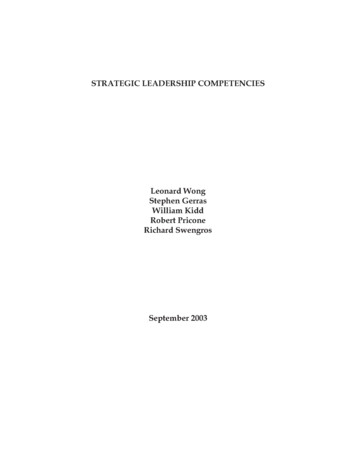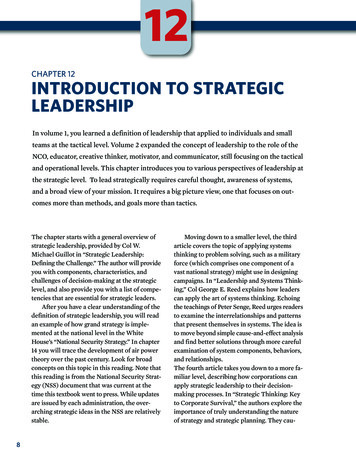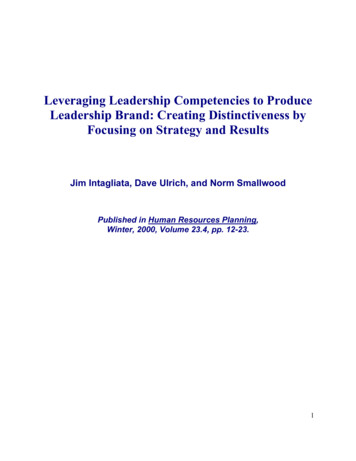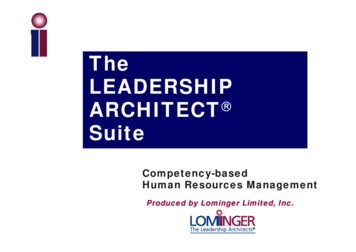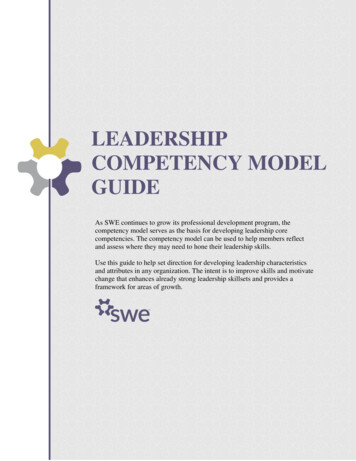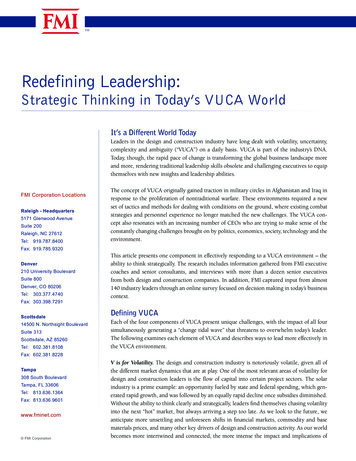
Transcription
STRATEGIC LEADERSHIP COMPETENCIESLeonard WongStephen GerrasWilliam KiddRobert PriconeRichard SwengrosSeptember 2003
*****The views expressed in this report are those of the authors and do not necessarily reflect the officialpolicy or position of the Department of the Army, the Department of Defense, or the U.S. Government.This report is cleared for public release; distribution is unlimited.*****ii
FOREWORDOn December 21, 2001, the Chief of Staff of the Army tasked the U.S. Army War College toidentify the strategic leader skill sets for officers required in the post-September 11th environment.The following report is the result of that tasking. Dr. Leonard Wong, assisted by four U.S. Army WarCollege students, reviewed the strategic leadership literature, interviewed corporate leader developers,analyzed the leader development system, and gathered the views of key leader developers in theArmy. They distill the essence of strategic leadership into six metacompetencies that not only describestrategic leadership, but also provide aiming points for an integrated leader development system.DOUGLAS C. LOVELACE, JR.DirectorStrategic Studies Instituteiii
SUMMARYThe strategic leadership literature in both the academic and military contexts is replete with longlists of the knowledge, skills, and abilities needed by strategic leaders of the future. Unfortunately, longcomprehensive lists are problematic. At the individual level, it is difficult to assess one’s leadershipability when the lists suggest that a strategic leader must “Be, Know, and Do” just about everything.At the institutional level, the long lists make it difficult to focus an institution’s attention and resourceson leader development when the desired endstate is so broad. Hence, the task of identifying thecompetencies of future strategic leaders becomes one of reducing the lists to a few metacompetenciesthat will prove useful in: a) directing leader development efforts in the process of producing leaderswith strategic leader capability, and b) facilitating self-assessment by officers of their strategic leadercapability. Looking across the existing literature on strategic leadership, the current lists of Armystrategic leader competencies, and the future environment of the Objective Force, six metacompetenciescan be derived: identity, mental agility, cross-cultural savvy, interpersonal maturity, world-class warriorwarrior,and professional astuteness. These metacompetencies describe the strategic leadership necessary for thefuture Army.v
STRATEGIC LEADERSHIP COMPETENCIESOn December 21, 2001, the Chief of Staff of theArmy (CSA) tasked the U.S. Army War College(USAWC) to identify the strategic leader skill setsfor officers required in the post-September 11thenvironment. In his charter guidance, the CSAspecifically stated:of the “strategic Captain” or “strategic Corporal”guarding the Brcko Bridge. This use of “strategic”broadens the definition to such a degree that allsoldiers should be strategic. On the other hand,“strategic” is often used in the narrow sense withthe view that the Army’s strategic leadershipresides solely in the general officer ranks. Aneven more narrow interpretation views strategicleaders only at the 3-star level and above.This report assumes that future strategic leadercapability will be required at the Brigade-levelcommander (i.e., the Stryker Brigade CombatTeam level) or the O-6 level staff officer who willhave increased strategic responsibilities. Thisdistinction is important for several reasons. First,stating that strategic leader capability, but notnecessarily strategic leadership, is required at theO-6 level recognizes that senior officers will needto think strategically, even if they are not in troopleading positions. For this study, “strategic”refers to a way of thinking—not just a level of warbeyond tactical and operational. Strategic leadercapability is required in those officers who haveincreased responsibility for an organization, whoare concerned with internal as well as externalspheres of influence, and who are surroundedby ambiguity and complexity.1 Second, shiftingstrategic leader capability down to the colonellevel greatly expands the target population ofany leader development efforts. Strategic leaderdevelopment must become more deliberate ifthe number of officers requiring strategic leadercapabilities increases from 300 general officers toseveral thousand colonels.The use of the phrase “strategic leadercapability” has significant implications.Itrecognizes that although not all colonels orgeneral officers are in strategic leader positions,they still can (and should) possess a level ofstrategic leader capability.Strategic leadercapability also implies a potential that is notinstantly acquired, but needs to be developed andmatured over time.This report also assumes that the comprehensive Army Training and Leader DevelopmentThe first of the critical areas to be examinedis the identification of strategic leader skillsets for officers in the post-September 11thenvironment, and those necessary to meet theleadership requirements of the Objective Force.In conducting the study, the student studyteam must start with the Army Training andLeader Development (ATLD) Panel (Officer)recommendations as a baseline, and build on thegreat work already done in this arena. In additionto strategic skill sets, the required knowledge andattributes of the future Objective Force leadershould also be discussed.A research group of four students and afaculty advisor completed the following reportafter extensive research and analysis. Researchvisits conducted by the team included the Centerfor Army Leadership, the Objective Force TaskForce Office, the Army Research Institute for theBehavioral and Social Sciences, U.S. Army CadetCommand, the U.S. Military Academy, Trainingand Doctrine Command headquarters andschools, and the leader development offices in theOffices of the Deputy Chief of Staff for Personnel(DCSPER) and Operations and Plans (DCSOPS).Additionally, the group consulted with leaderdevelopment experts in organizations such asthe Center for Creative Leadership, Bristol-MyersSquibb, and Strategic Leadership Solutions.Assumptions.The CSA charter began by stating the need toidentify the skill sets required of future strategicleaders.Before identifying these skill sets,however, it is useful to define what a strategicleader of the future actually means. Ironically,“strategic” is often used at both ends of thehierarchical spectrum. It is not uncommon to hear1
(ATLD) Panel (Officer) report adequately coveredthe development of direct and organizationallevels of leadership. Thus, there is no reasonto examine the development of leadershipcompetencies other than strategic leadershipcompetencies. This report also assumes that theleadership competencies required at the directand organizational levels will be resident inemerging strategic leaders.Finally, this report assumes that a postSeptember 11th environment is the same as theObjective Force environment. Both environmentsinvolve breaking the linear method of warfareand allowing the Nation to directly applyoperational maneuver from strategic distancesthrough the use of joint and coalition forces. Bothperspectives require strategic leaders capable ofhandling a more complex, uncertain, and globalsecurity environment.2vision with the mission and environment througha strategic plan. Aligning consists of ensuring theorganizational structure, systems, and operationalprocesses all contribute to achieving the missionand vision. Empowering is igniting the latenttalent, ingenuity, and creativity in the people toaccomplish the mission.Other leadership theorists bring up aspectsof strategic leadership not included in Covey’stypology. In his research on future strategicleadership, James F. Bolt focuses less on theenvironment and more on the leader.5 He arguesthat there are three dimensions of a leader:business, leadership, and personal effectiveness.The business dimension has been traditionallythe focus in executive development. This dimension includes the creation of new kinds oforganizations, leading change, and how theorganization works. The leadership dimensionhas typically been overlooked because manypeople do not believe it can be taught. Accordingto Bolt, this dimension is developed by the studyof a broad range of classical and contemporaryleadership theories and skills. The personaleffectiveness dimension, according to Bolt, has beenneglected because of the widespread view thatwork and personal matters must be separated.The personal dimension concentrates on helpingto clarify and develop an individual’s purpose,vision, values, and talents. The emphasis onself-reflection is found in the “self-leadership”literature that is becoming popular and is actuallyas old as Thales (“Know thyself”) or Shakespeare(“To thine own self be true.”).A related aspect emerging in the strategicleadership literature is self-efficacy.6 Self-efficacyrefers to individuals’ judgments about theirperceived capabilities for performing specifictasks. Self-efficacy is the result of life experiencesthat teach one that one can, in fact, take actionsthat will effectively have an impact on one’senvironment. This concept parallels the findingsof the Army Training and Leader Development(ATLD) Panel. In the ATLD report, one of thetwo leadership competencies for the 21st centuryis self-awareness. Self-awareness is the abilityto assess abilities, determine strengths in theStrategic Leadership.The search for strategic leader competencies3is a natural progression of the research in the fieldof leadership. In the late 1980s, some social scienceresearchers began to question whether leadershipactually made a difference in organizationswhile others suggested that perhaps the studyof leadership had reached its culminating point.Rather than disappearing, however, the study ofleadership took on new energy with an emphasison leadership of organizations, rather than thetraditional leadership approaches that focused onface-to-face interaction at lower levels. Studiesof transformational leadership, organizationalculture, visionary leadership, organizationalchange, and charismatic leaders reinvigorated thefield of leadership. Thus, the notion of strategicleadership was introduced.While lists of leadership competencies werevery popular in the 1980s, the most recentliterature distills strategic leadership to a fewkey skills and competencies or a process. Forexample, Stephen Covey states that strategicleaders have three basic functions: pathfinding,aligning, and empowering.4 Pathfinding dealswith tying the organization’s value system and2
environment, and learn how to sustain strengthsand correct weaknesses. The ATLD report alsoargues that a key leader competency is adaptability.According to the panel, adaptability is the abilityto recognize changes to the environment, todetermine what is new, what must be learnedto be effective, and includes the learning processthat follows that determination.7Karl Weick states that in a world ofuncertainty and doubt, leaders must focus oncertain properties. Two of those properties areimprovisation and lightness.8Improvisationinvolves the flexible treatment of preplannedmaterial. It is not about making somethingout of nothing. Instead, it is about makingsomething out of previous experience, practice,and knowledge. Improvisation is something thatis almost intuitive to good leaders at the tacticallevel, but seldom is addressed at the strategiclevel.Weick’s novel concept of lightness refers tothe ability to drop heavy tools that are no longeruseful. Weick’s analogy is the foreman who yells,“drop your tools,” to wildland firefighters whoare trying to outrun an exploding fire. Firefighterswho refuse to drop heavy tools such as chainsawsare prone to be overtaken by the fire and perish(as has happened at least 23 times since 1990).To strategic leaders, the now-unwieldy tools arethose that presume the world is stable, knowable,and predictable. Future strategic leaders must beable to drop outmoded perspectives, methods, orassumptions in a world of uncertainty.In their review of strategic leadership, KimBoal and Robert Hooijberg distill the essence ofstrategic leadership to three factors—effectivestrategic leaders must create and maintainabsorptive and adaptive capacity in additionto obtaining managerial wisdom.9 Absorptivecapacity involves the ability to learn byrecognizing new information, assimilating it,and applying it. Adaptive capacity involves theability to change due to variations in conditions.Managerial wisdom consists of discernment andintuition. Boal and Hooijberg’s assertion thatabsorptive and adaptive capacities are requiredat the strategic level of leadership is very similarto the Army’s emphasis on self-awareness andadaptability. Although the Army competenciesare intended to apply to all levels of leadership,not just strategic leaders, it is interesting to seethe parallel development of parsimonious leadercapabilities in both the military and academicliterature.Strategic Leadership in the Military.In 1991, the U.S. Army War College hosteda conference on the fledgling field of strategicleadership. At that conference, strategic leadershipaspects were based on Jaques’s Stratified SystemsTheory (SST).10 SST essentially argues that thereare critical tasks that must be performed byleaders in effective organizations. At each higherlevel in an organization, these tasks becomeincreasingly complex and qualitatively different.Consequently, leaders at the strategic levels musthave higher levels of cognitive complexity—theability to deal with abstract, longer timeframeconcepts. The influence of SST on the ArmyWar College (and the broader Army) is evidentwith the emphasis on cognitive complexity thatpermeates much of the strategic leadershipinstruction.In its Strategic Leadership Primer,11 the ArmyWar College provides a list of strategic leadercompetencies using the “Be, Know, Do” typology.The list is extremely comprehensive and appearsto capture every possible aspect of leadership.BE (Disposition—values, attributes): The Values Champion—the standardbearer beyond reproach Master of the Strategic Art—ends, ways,means Quintessential Student of History Comfortable with Complexity High Personal Stamina—physical, mental,stress management Skilled Diplomat Possesses Intellectual Sophistication—alternative frames of reference, patternrecognition, and able to see 2d, 3rd, and4th-order effects.3
KNOW (Disposition—skills):Conceptual—o Envisioning-anticipating the future,proactive thinking—practices critical,creative, reflective thinkingo Frame of Reference Development—including systems understanding,scanning, pattern recognitiono Problem Management—competingissues, no right answers, ability torecognize and ignore irrelevant issueso Critical Self-Examinationo Critical, Reflective Thoughto Effective within Environment ofComplexityo Skillful Formulation of Ends, Ways,Means.DO (Action—influencing, operating, andimproving): Provide for the Future—visioning (longterm focus, time span, perspective) Initiator of Policy and Directive Shape the Culture—Values-basedorganization, leverage diversity,understanding and accepting differences,multiple perspectives Teach and Mentor the Strategic Art Manage Joint/Combined and InteragencyRelationships Manage National-Level Relationships Represent the Organization Leverage Technology Lead and Manage Change—creating andbuilding “learning organizations” Build Teams and Consensus at StrategicLevel (can’t dictate action at this level)—co-opting, coalition building, negotiating,etc. Practice the Strategic Art—allocateresources, develop and execute strategicplans derived from the interagencyprocess.Interpersonal—o Communication—to a muchbroader audience; negotiations,consensus-building across a varietyof stakeholders; systems knowledge;sophisticated persuasion skillso Inspire Others to Acto Organizational Representation—tointernal and external audiences/stakeholderso Skillful Coordination of Ends, Ways,Meanso Master of Command and PeerLeadership.Similarly, in FM 22-100, Army Leadership, theArmy’s doctrinal leadership manual, the skillsand actions required of strategic leaders are acumulative list of 41 competencies addressingthe direct, organizational, and strategic levels.12Twenty-one competencies are provided for thestrategic level alone:Technical—o Systems Understanding—political,economic, cultural, logistical, forcemanagement, and joint/combinedinterrelationships, etc.o Recognize and UnderstandInterdependencies—systems,decisions, organizations, etc.o Information-age TechnologicalAwareness—next generationawareness, sophisticated time/spaceselectiono Skillful Application of Ends, Ways,Means.FM 22-100, Army Leadership:Strategic Level Skills and Actions—o Communicatingo Using dialogueo Negotiatingo Achieving consensuso Building staffso Envisioningo Developing frames of referenceo Strategic arto Motivatingo Leveraging technologyo Executingo Communicating a vision4
DevelopingDecisionmakingLeading changeStrategic planningLearningStrategic assessingTranslating political goals into militaryobjectiveso Buildingo Dealing with uncertainty andambiguity.description, but is not obvious in the wordsprofessional astuteness.Understanding themeaning and intent behind each metacompetencyis much more important than creating a catchymnemonic containing the first letter of each of thesix labels. Similarly, the metacompetency labelsmay be misinterpreted if separated from theirdescriptions. For example, cross-cultural savvyincludes the ability to work across organizationalboundaries, but the metacompetency can benarrowly misinterpreted to refer to working onlyacross national boundaries. In other words, thesix metacompetency labels were not developed asa stand-alone list. The concepts behind the labels,not the labels themselves, are the focal points forleader development and assessment.The following section describes the six metacompetencies. After a brief discussion of each,the development of each in future officersis examined using the three pillars of leaderdevelopment—institutional, operational, andself-development. This report is not intendedto be an exhaustive explanation of strategicleadership—the civilian literature does thatadequately. It is also not intended as a blueprintto overhaul the Army’s leader developmentsystem. Instead, this report contrasts the futureenvironment with the current status of strategicleader development and suggests some aimingpoints for leader development efforts.oooooooIn one sense, the Army War College and FM22-100 lists of strategic leader competencies aretoo comprehensive. At the individual level, it isdifficult to assess one’s leadership ability whenthe lists suggest that a strategic leader must be,know, and do just about everything. At theinstitutional level, the lack of parsimony makesit difficult to focus an institution’s attention andresources on leader development when such abroad array of competencies is advocated. Hence,the task of identifying the competencies of futurestrategic leaders becomes one of reducing the liststo a few metacompetencies13 that will prove usefulin: a) directing leader development efforts in theprocess of producing leaders with strategic leadercapability, and b) facilitating self-assessment byofficers of their strategic leader capability.Looking across the existing literature onstrategic leadership, the current lists of Armystrategic leader competencies, and the futureenvironment of the Objective Force, six metacompetencies can be derived: identity, mentalagility, cross-cultural savvy, interpersonal maturity,world-class warriorwarrior, and professional astuteness.Before addressing each metacompetency, itshould be noted that concentrating on justsix does provide focus, but there are someassociated disadvantages. First, some skillsand abilities are not explicitly described by ametacompetency label. For example, strategicleaders need to be politically savvy—knowingwhen to compromise, understanding that manystrategic decisions are not black and white, andknowing what is best in the long run for theNation and the Army. This ability is capturedin the professional astuteness metacompetencyStrategic Leadership Metacompetencies.Identity. This metacompetency is derived fromthe work of Douglas Hall who heavily influencedthe conclusions of the ATLD Panel. Accordingto Hall, identity is “the ability to gather selffeedback, to form accurate self-perceptions, andto change one’s self-concept as appropriate.”14The ATLD report uses the term self-awareness anddescribes it as “the ability to understand how toassess abilities, know strengths and weaknessesin the operational environment, and learn how tocorrect those weaknesses.”15 The metacompetencyof identity moves beyond simply knowing one’sstrengths and weaknesses as connoted by selfawareness. It includes the understanding ofone’s self-concept as an officer in the Army.5
Identity also includes an understanding of one’svalues and how they match the values of theArmy. Identity implies maturation beyond selfawareness as officers come to understand whothey are, not just how well they do things.Identity, as opposed to self-awareness, alsobrings in aspects of development over a career.In the corporate world, as an executive advancesin levels of responsibility, “he or she must learnto change the basis of his or her self-identityaway from individual contributions as the basisfor self-esteem and toward defining personalvalue and esteem through the accomplishmentsof subordinates.”16 In an officer’s developmentof strategic leadership capability, the metacompetency of identity acknowledges that the roleof a strategic leader goes beyond personalcontributions and shifts to serving as a catalystfor success by subordinates.The development of the identity metacompetency in officers can begin as early asprecommissioning. In the early stages of anofficer’s career, identity focuses more on therecognition of one’s strengths and weaknesses,but it also includes the establishment of afoundation of continual self-assessment and thedesire to adjust one’s self-concept when needed.In the institutional realm of leader development,identity can be increased through self-assessmenttools, simulations, peer evaluations, and coaching.In the operational arena of leader development,identity can be improved through After ActionReviews, 360-degree feedback, Officer EvaluationReports, rewarding personal growth, and thecounsel of a mentor. Finally, identity can befostered through officer self-development withreading lists and the use of a lifelong plan.Mental Agility. In addition to self-awareness,the ATLD report recommends that the Armyfocus on developing the enduring competency ofadaptability. It is defined as “the ability to recognizechanges in the environment; to determine what isnew, what must be learned to be effective, andincludes the learning process that follows thatdetermination, all performed to standard andwith feedback.”17 Mental agility builds on theability to scan and adjust learning based on theenvironment, and brings aspects of cognitivecomplexity, improvisation, and lightness foundin the strategic leadership literature.Strategic leaders operate in an environmentof ambiguity and uncertainty. Typical strategicsituations lack structure, are open to varyinginterpretations, and potentially pertinentinformation is often far-flung, elusive, cryptic,or even contradictory.18 Mentally agile strategicleaders possess the requisite cognitive skillsto navigate in this milieu and are adaptableenough to alter their actions and those of theirorganizations to function in this complexenvironment.From a cognitive perspective, strategicleaders must learn how to scan the environment,understand their world from a systemsperspective, and eventually envision differentfutures and directions for their organization.Scanning involves a constant search forinformation that affects current assumptions,along with the future of the organization. Officerswith mental agility search for more informationand spend more time interpreting it.19 They alsoanalyze large amounts of sometimes conflictinginformation and try to understand why thingshappen and identify possible courses of actionto affect events. Mentally agile leaders knowwhich factors really matter in the big picture;they identify root causes quickly, display a keensense of priority, relevance and significance, andintegrate information from a variety of sourceswhile detecting trends, associations, and causeeffect relationships. Just as important, mentallyagile leaders translate complex situations intosimple, meaningful explanations that others cangrasp.Mentally agile leaders efficiently gather andprocess relevant information in order to processit from a systems perspective and then envisionfeasible futures within increasingly longer timehorizons.20 From a systems perspective, theychallenge assumptions, facilitate constructivedissent, and analyze second- and third-orderconsequences of their decisions.21Mentallyagile leaders are comfortable making importantdecisions with only part of the informationavailable. More importantly, they know whento act and when to experiment to validate beliefs6
or assumptions. Once mentally agile strategicleaders have scanned the environment, processedinformation from a systems perspective, andenvisioned the future effect of that information onthe organization, they then adapt and implementlearning mechanisms to alter the processes,structure, and behaviors of their organization toaccommodate their envisioned future.Because the level of the organization ratherthan the officer’s rank determines the nature ofproblems that will be encountered and the skillsrequired, efforts to develop mental agility mustbegin early in an officer’s career and not be delayeduntil an officer is about to be placed in charge ofan organization at the strategic level.22 From aschool perspective, officers can be introduced toquantitative decisionmaking, critical thinking,and systems thinking during precommissioningand the officers’ basic course. Throughout theofficer’s time at branch schools, simulationsallow the officer to adapt and anticipate changingparameters and assumptions.23 Mental agility canbest be improved with a program of instructionthat encourages students to develop multiplepoints of view, consider alternative explanationsand argue the merits of competing solutions tocomplex problems, synthesize as well as analyze,challenge existing frames of reference, andengage in collaborative tasks. In the operationalenvironment, the Army culture determinesthe amount of discretion given to commandersto encourage innovation and improvisation.Ambiguous scenarios at the combat trainingcenters and job variety in the assignment processalso foster mental agility through the operationalleader development pillar. Self-development ofmental agility can be done throughout a careerby activities that stretch the horizons of theofficer. Reading future studies, publishing, oreven reading business journals can also increasemental agility. Of course, demanding periodsof an officer’s career (e.g., S-3 or XO time) affordvery little time for reading or self-development.Nevertheless, it is possible to improve mentalagility through self-development when theopportunity arises.Cross-cultural savvy. With the increasingfrequency of coalition warfare and an emphasison theater security cooperation, the necessityfor cross-cultural savvy is obvious. The Army’sfuture leaders clearly need to be well-versedin interacting with cultures outside the U.S.borders. Cross-cultural savvy, however, refersto more than just the ability to work with nonU.S. militaries.The metacompetency crosscultural savvy includes the ability to understandcultures beyond one’s organizational, economic,religious, societal, geographical, and politicalboundaries. A strategic leader with crosscultural skills is comfortable interacting withand leading joint, international, interagency, orinterorganizational entities.Future strategicleaders must be able to work with a diversegroup of people and organizations ranging from24-year-old congressional staffers, to NorthernAlliance warlords, to representatives from nongovernmental organizations.While cross-cultural skills have beendesirable in the past, they will be even morecritical for future strategic leaders due to severalfactors. First, globalization has vastly increasedinteraction with other nations. Second, theglobal war on terrorism is illustrating thatthe Army must coordinate closely with otherservices, agencies, and organizations in the newnational security environment. Third, the Armytraditionally has been accused of being somewhatinept in its dealings with Congress and the media.As societal exposure to the military decreases,it becomes increasingly important for Armyofficers to tell the Army story to those outside theArmy culture. Finally, although the United Statesremains the world’s only superpower, unilateralmilitary action is becoming less common.Coalitions will continue to be vital to the securitystrategy.Cross-cultural savvy implies that an officercan see perspectives outside his or her ownboundaries. It does not imply, however, thatthe officer abandons the Army or U.S. culture inpursuit of a relativistic worldview. Instead, thefuture strategic leader is grounded in Nationaland Army values, but is also able to anticipate andunderstand the values, assumptions, and normsof other groups, organizations, and nations.Cross-cultural skills can be developed in future7
strategic leaders as early as precommissioningwith courses in foreign languages, internationalrelations, or regional studies. Time spent abroador interning with various organizations can alsohelp broaden the horizons of officers. In theinstituti
stating that strategic leader capability, but not necessarily strategic leadership, is required at the O-6 level recognizes that senior offi cers will need to think strategically, even if they are not in troop leading positions. For this study, “strategic” refers to a way of thinking
